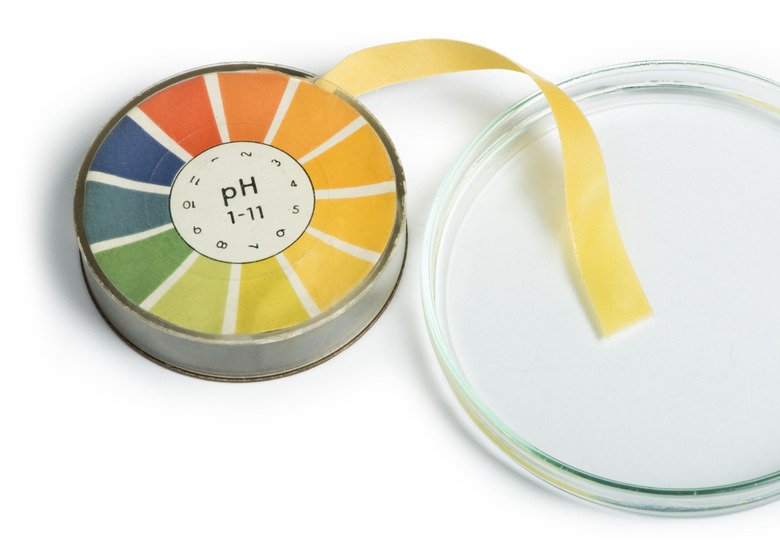How To Find The Concentration When You're Given The pH
The pH scale ranges from 0 to 14 and is a measure of acidity or alkalinity. In the classroom or lab, there are many benefits to knowing the pH of a substance. The pH can be used to determine what a substance is and how it will react under certain circumstances.
It can also be used to determine the concentration of hydronium or hydroxide ions, which can lead to determination of the concentration of other ions in the solution.
You can use the pH equation below to perform the calculation to solve for unknowns.
Hydrogen ions (H+) in aqueous solutions form bonds with water molecules to form hydronium ions (H3O+).
2 H2O ==> H3O+ **+** OH−
pH Equation
pH Equation
The following equation is a fundamental and useful staple of chemistry and can be seen as somewhat of a pH calculator. If you know the pH, you can solve for the hydronium ion concentration and conversely, you can solve for pH if you know the concentration of hydronium ions.
pH = − log [H3O+]
The pH of a solution is equal to the negative logarithm of the hydronium ion (H3O+) concentration.
Example 1: Find pH from [H3O+].
In a 1.0 L sample of 0.1 M hydrochloric acid (HCl) the concentration of hydronium ions is 1 × 10-1. What is the pH?
pH = − log [H3O+]
pH = − log (1 × 10-1 )
pH = − ( − 1)
pH = 1
pH Conversion
pH Conversion
Example 2: Find [H3O+] from pH
If the pH of the solution is 4.3. What is the concentration of hydronium ions?
The first step is to rearrange the equation:
[H3O+] = 10−pH
**[H3O+] = 10−4.3 [H3O+] = 5.01 × 10-5
Example 3: What if it's a base?
Use the ion-product constant for water (Kw).
Kw = 1 × 10-14 = [H3O+] × [OH]
[H3O+] = (1 × 10-14 ) / [OH-]
What is the pH of a solution if [OH-] = 4.0 x 10-11 M?
Step 1
[H3O+] = (1 × 10-14 ) / [OH-]
[H3O+] = ( 1 × 10-14 ) / (4.0 x 10-11 )
[H3O+] = 0.25 × 10-3
Step 2
pH = − log [H3O+]
pH = − log (0.25 × 10-3 )
pH = − ( − 3.60)
pH = 3.60
Significant Figures
Significant Figures
Although the rules for determining significant figures are fairly rigid, calculations for pH are somewhat special in that only the numbers to the right of the decimal are counted as sig figs!
Acid Dissociation Constant (Ka)
Acid Dissociation Constant (Ka)
The acid dissociation constant is the portion of an acid in the ionized form. Weak acids have small Ka values because the majority of the acid remains undissociated. Carbonic acid is a good example of a weak acid. The equilibrium equation is:
H2CO3 (aq) ↔ HCO3 (aq) − + H+ (aq) Ka = 4.3 x 10-7
Since carbonic acid is a diprotic acid, and can donate another H+, the second dissociation equation is:
HCO3(aq)− ↔ CO32−(aq) + H+ (aq) Ka = 4.8 x 10-11
Strong acids have large dissociation constants; they completely dissociate in water. Nitric acid is a good example of a strong acid. The equilibrium equation for nitric acid is:
HNO3 (aq) ↔ NO2 − + H+ Ka = 40
The Ka value of 40 is substantially more significant than that of carbonic acid, which was 4.3 x 10-7.
Cite This Article
MLA
McConnell, Tracy. "How To Find The Concentration When You're Given The pH" sciencing.com, https://www.sciencing.com/concentration-youre-given-ph-8303572/. 16 March 2020.
APA
McConnell, Tracy. (2020, March 16). How To Find The Concentration When You're Given The pH. sciencing.com. Retrieved from https://www.sciencing.com/concentration-youre-given-ph-8303572/
Chicago
McConnell, Tracy. How To Find The Concentration When You're Given The pH last modified August 30, 2022. https://www.sciencing.com/concentration-youre-given-ph-8303572/
